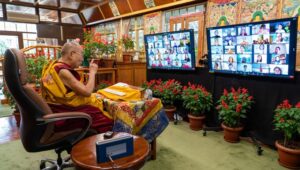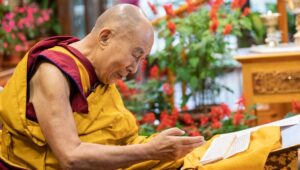
His Holiness addressing the virtual audience of Asian Buddhist on September 9, 2021
Photo: OHHDL
His Holiness the 14th Dalai Lama, has completed a two-day introduction to Buddhism online teaching based on Chandrakirti’s auto-commentary to his treatise Entering into the Middle Way. The teaching took place on September 8-9 at the request of a group of Buddhists from Singapore, Thailand, Malaysia, Indonesia, Vietnam and Hong Kong.
His Holiness told his audience, “I have received the transmission of the root text from my Abbot, Kyabjé Ling Rinpoché and the transmission of the auto-commentary from Sakya Khenpo Kunga Wangchuk”.
He then reminded his followers that Buddha Shakyamuni started teaching the Dharma more than 2,500 years ago. However, His Holiness made it clear to his followers that they should not take his teachings for granted and follow them blindly, but should examine the teachings to see if they find it reasonable and would have the effect of transforming their minds.
Before going into the text, His Holiness briefly explained the history of Tibetan Buddhism by saying that in seventh century Tibet, Emperor Songtsen Gampo commissioned the creation of a Tibetan alphabet. Despite close relations with China, Songtsen Gampo chose to model the Tibetan alphabet on the Indian Devanagari (Sanskrit) script and not on Chinese script. A century later, Emperor Trisong Detsen turned to India once again when he invited the eminent Nalanda scholar Shantarakshita to establish Buddhism in Tibet.

His Holiness the Dalai Lama reading from Chandrakirti’s auto-commentary on “Entering the Middle Way”
Photo: OHHDL
His Holiness continued by saying that following the development of the Tibetan language, the work of translating Buddhist literature into Tibetan started and the result was the 100 volumes of the Kangyur, the translated words of the Buddha, and more than 200 volumes of the Tengyur, the translated collection of treatises of subsequent masters. These translated works formed the basis of Buddhist education in Tibet.
“When I was very young” said His Holiness, “I memorised Entering into theMiddle Way and could recite it aloud without knowing what it meant. In due course, I found out by studying the text word by word. A key aspect of the Nalanda Tradition was to take a reasoned, questioning approach to the books we studied. These days, if I can, I read a few pages of Chandrakirti’s auto-commentary every day, which prompts me to reflect on the way things exist. I take great inspiration from verses at the end of the sixth chapter”.
His Holiness recited verses from the texts and gave an explanation, then answered questions from his virtual audience.
On the second day he continued with a teaching on Chandrakirti’s auto-commentary to his treatise Entering into the Middle Way.
His Holiness reiterated “we all have Buddha nature. The true nature of the mind is clarity and awareness. The subtlest mind has an innate quality of luminosity and awareness. There are no stains or afflictions at that level. The obstacles that stain the mind are not part of the mind. Ignorance and so forth can be eliminated. When you understand this and can combine an understanding of conventional and ultimate reality, you will be led to the state of omniscience”.
His Holiness concluded by saying “you’ve received teachings about bodhichitta*, make this your daily practice. In time you will see some transformation. I’ve meditated on bodhichitta and emptiness for decades and I’ve observed change in myself. Please keep in mind that if I can see change, so can you.”
* In Buddhism, bodhicitta “enlightenment-mind”, is the mind that strives toward awakening, empathy, and compassion for the benefit of all sentient beings (Wikipedia)




 Print
Print Email
Email